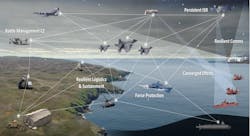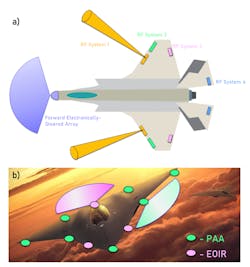Next-generation sensing systems enable evolving defense applications
The key to defeating an adversary? Finding and capitalizing on differentiating advantages.
Easier said than done. After all, there’s constant evolution across the entire landscape from the battlefields, weaponry, and the enabling equipment. As such, today’s battlespace more often resembles fast-paced, high-resolution video games than historical war fields. Simply put, war has digitized, and it’s a trend that is only likely to intensify as the data-driven digital space continues to permeate our reality.
In a digital world, how quickly you can collect, analyze, and use all types of data often makes a significant difference in the outcome. “Being able to make good decisions quickly is such a big differentiator in the modern and future battlespaces,” says Michael Hoff, senior research engineer and program manager for Lockheed Martin’s Advanced Technology Laboratories. “So platform processes and functions that minimize latency enable the proverbial Observe, Orient, Decide, Act (OODA) loop to cycle that much faster.”
Today’s equipment depends on an array of systems (radar, telecom, etc.) to guide aircraft, chart flight paths, and manage communications (see Fig. 1). The core technology currently driving these applications generates tightly directed beams for communication and sensing. Of course, higher-fidelity applications require multifunction sensors and the ability to quickly move vast amounts of data to and from the processing unit for timely, actionable insight. Keeping pace means moving beyond the traditional electrical interconnects. Defense platforms of all kinds have the need to transport and process growing data volumes while maximizing efficiency and minimizing latency.
“Looking at next-generation and even generation-after-next platform concepts which will be responsive to future battlespace demands, the rate of increase in the required data volumes isn’t showing any signs of slowing,” Hoff says. “As the complexity and amount of data grows on the battlefield, faster decision-making is essential. New sensory platforms that leverage Ayar Labs’ advanced optical I/O solution are important across Department of Defense applications to capture, digitize, transport, and process spectral information.”
Lockheed Martin is partnering with Ayar Labs in developing multichip package (MCP) solutions, placing high-density, high-efficiency optical I/O chiplets in the same microelectronics package as the radio-frequency (RF) processing devices. The development and integration of Ayar Labs’ TeraPHY optical I/O chiplets and SuperNova light source represent a faster, more efficient, and more reliable transfer of data throughout the platform. This is important for next-generation architectures that will use phased-array apertures to connect systems and people to make smarter, faster decisions (see Fig. 2).How it works
Ayar Labs’ optical I/O solution uses industry-standard high-volume, cost-effective silicon processing techniques to develop high-speed, high-density, low-power optical interconnect CMOS “chiplets” and multiwavelength lasers to replace traditional electrical-based I/O. “The TeraPHY chiplet is the first monolithic, in-package optical I/O chiplet that eliminates bottlenecks in traditional copper-based systems. The combination of the TeraPHY optical I/O chiplet with SuperNova, a ‘first of its kind’ multiwavelength optical source, delivers up to 1000X bandwidth density at 1/10th the power of a standard electrical I/O, and enables ASICs to communicate with each other across a wide range of distances (from millimeters up to two kilometers),” says Ayar Labs CEO Charlie Wuischpard. “TeraPHY optical I/O chiplets use microrings to modulate the SuperNova laser, translating electrical digital data into light for transmission. This process dramatically scales bandwidth, enabling hundreds of devices on-die for breakthrough density, power savings, and improved performance.”
These multifunction sensory systems also create a reconfigurable architecture. “In prior designs, there was just a one-to-one sensor to platforms—providing no reconfigurability,” says Hoff. “If you need to access the spectrum, having a reconfigurable system allows the system to use the sensors it needs at that time. This requires a high-bandwidth routing interconnect system, and it’s where Ayar Labs’ optical I/O solution becomes important to move those large data volumes.”
Such technology can fit a variety of applications such as cloud/data center, telecommunications, HPC/AI, and the intelligent edge. “The foundational value of our technology is equally applicable across these applications: to move data between microchips with much greater bandwidth, at lower latency and power,” says Wuischpard. From a military perspective, the possible applications of optical-I/O-enabled solutions include ground-to-air communications with orbital vehicles, phased-array radar and communication systems, unmanned aircraft systems, communications among interconnected satellites, as well as other applications (such as air traffic control systems in congested airspace in the aviation industry).
Addressing obstacles
Numerous simultaneous challenges exist when architecting a converged phased-array system. “You have the requirements that the RF components need to satisfy to achieve the desired spectrum access and agility,” says Hoff. “Then you have the digital processing requirements needed to digest and make sense of this information; and finally, the data movement requirements which enable the low-latency flow of information between and among sensors and processing resources.”
Unique aspects exist when working on aerospace and defense applications, including extreme temperatures, radiation effects, and electronic warfare (EW) interference. Tradeoffs also exist in any type of electronic design. “In aerospace development, size, weight, and power (SWaP) are at the heart of many design issues. Reducing the size and weight of components and minimizing power consumption are integral to the strategic and logistical imperatives of modern aerospace operations,” says Wuischpard.
There’s also the challenge of blending this next-generation technology with the many pieces of legacy equipment currently deployed across the defense landscape. “Traditional components such as RFICs (radio-frequency integrated circuits) and digital-signal-processing units (DSPs) can continue to be used,” says Wuischpard. “The addition of optical transceivers will allow data from an array of sensors to be processed together in a central location and used for various applications.”
Deploying optical-I/O-based sensing systems is a multi-year program with multiple stages. And because it is research and development, there isn’t a strict timeline for deployment. But the current plan is to complete work in 2024 and transition it to the various Lockheed Martin business areas.
About the Author
Peter Fretty
Market Leader, Digital Infrastructure
Peter Fretty began his role as the Market Leader, Digital Infrastructure in September 2024. He also serves as Group Editorial Director for Laser Focus World and Vision Systems Design, and previously served as Editor in Chief of Laser Focus World from October 2021 to June 2023. Prior to that, he was Technology Editor for IndustryWeek for two years.
As a highly experienced journalist, he has regularly covered advances in manufacturing, information technology, and software. He has written thousands of feature articles, cover stories, and white papers for an assortment of trade journals, business publications, and consumer magazines.


